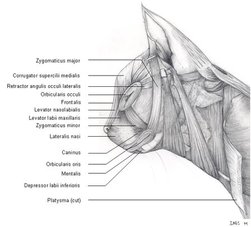The Cat Facial Action Coding System (CatFACS) is a scientific observational tool for identifying and coding facial movements in cats. The system is based on the facial anatomy of horses and has been adapted from the original FACS system used for humans created by Ekman and Friesen (1978). The CatFACS manual details how to use the system and code the facial movements of cats objectively. The manual and certification is freely available (see below).
More info regarding the development of this FACS system can be found here:
Caeiro, Cátia C., Anne M. Burrows, and Bridget M. Waller. "Development and application of CatFACS: Are human cat adopters influenced by cat facial expressions?." Applied Animal Behaviour Science 189 (2017): 66-78.
APA
What CatFACS is:
What CatFACS isn't:
CatFACS is not an ethogram of facial expressions, and does not make any inference about any underlying emotion or context causing the movement. Instead this is an objective coding scheme with no assumption about what represents a facial expression in this species. It will not explicitally teach you cat facial expressions.
CatFACS
(A FACS system adapted for the domestic cat)
Accessing the manual
Accessing the Test
To access the CatFACS manual, please fill out the form below. Further details, including a link to the manual, will be sent to the email which you provide.
If you do not receive the manual within 24 hours (this is usually instant) please contact us.
To become a certified CatFACS coder, we encourage you to take the associated test. The CatFACS test involves trainees to accurately code the facial movements in a series of video clips.
The materials for the test, and further instructions, can be found with the manual, and can also be accessed via the form below.
The people behind it
CatFACS was developed thanks to the joint effort of:
- Bridget M. Waller, Department of Psychology, Nottingham Trent University.
- Anne M. Burrows, Department of Physical Therapy, Duquesne University
- Cátia Caeiro, School of Psychology, University of Lincoln, UK
Acknowledgments
This work was supported by a Feline Friends Research Donation to Bridget Waller.
We would like to thank the following people that contributed to the CatFACS manual production:
- Daniel Mills for establishing a collaboration between University of Lincoln and University of Portsmouth for the project development.
- Catarina Ferreira, Daniel Mills, Lauren Finka, Sarah Ellis and Will Higgs (skullsite.co.uk) for the videos and photographs contributions.
- Inês Martins for drawing the anatomical images.
- Alison, Andrea Karis, April Turgutalp, Brusspup, Chester Smooshyface, Heliflyer7, Joe Martin, Katia Shifrin (k_shifrin(at)yahoo(dot)com, youtube.com/chikmuka), Kevin Christensen, Larry Graves (youtube.com/canadianstudmuffin), Laura Palmer & Wintermuse, llrnr, Molly Barr of Mythicbells Persian cats and kittens, Patrizia Piotti, Saffy, Hector & Millie, Sean Coonery (youtube.com/irixguy), Sijimi_soupzz, tiffcat.com, youtube.com/100eebiz, youtube.com/dsz, youtube.com/egawauemon1 for permission to use their clips from www.YouTube.com.
- Jennifer Wathan for the reliability assessment coding.
- And finally, to Daniel Mills and Jennifer Wathan for helpful comments on previous versions of this manual.
